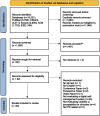Self-Management Systems for Patients and Clinicians in Parkinson's Disease Care: A Scoping Review
- PMID: 39392604
- PMCID: PMC11492088
- DOI: 10.3233/JPD-240137
Self-Management Systems for Patients and Clinicians in Parkinson's Disease Care: A Scoping Review
Abstract
Background: Digital self-management tools including mobile apps and wearables can enhance personalized care in Parkinson's disease, and incorporating patient and clinician feedback into their evaluation can empower users and nurture patient-clinician relationships, necessitating a review to assess the state of the art and refine their use.
Objective: This review aimed to summarize the state of the art of self-management systems used in Parkinson's disease management, detailing the application of self-management techniques and the integration of clinicians. It also aimed to provide a concise synthesis on the acceptance and usability of these systems from the clinicians' standpoint, reflecting both patient engagement and clinician experience.
Methods: The review was organized following the PRISMA extension for Scoping Reviews and PICOS frameworks. Studies were retrieved from PubMed, CINAHL, Scopus, ACM Digital Library, and IEEE Xplore. Data was collected using a predefined form and then analyzed descriptively.
Results: Of the 15,231 studies retrieved, 33 were included. Five technology types were identified, with systems combining technologies being the most evaluated. Common self-management strategies included educational material and symptom journals. Only 11 studies gathered data from clinicians or reported evidence of clinician integration; out of those, six studies point out the importance of raw data availability, data visualization, and integrated data summaries.
Conclusions: While self-management systems for Parkinson's disease are well-received by patients, the studies underscore the urgency for more research into their usability for clinicians and integration into daily medical workflows to enhance overall care quality.
Keywords: Parkinsonian disorders; Parkinson’s disease; digital health; self-management; telemedicine.
Plain language summary
Digital tools, such as smartphone applications and wearable devices, could help people with Parkinson’s disease manage their symptoms by using data and technology to provide support that is personalized to them and by supporting communication between patients and healthcare providers. This review studies current literature on these digital self-management systems for people with Parkinson’s disease. Of the 33 studies included in our review, we found that many of these systems combine different types of digital technologies (for example, a mobile app and a wearable sensor). The most common strategies to help support patients with self-management included in these digital tools were providing educational health content and symptom diaries. Only a few studies have considered healthcare providers’ perspectives on these systems. Those that did highlighted a need for better access to patient data, improved data presentation, and summaries of key health insights. While patients find digital self-management tools favorable, further research is needed to ensure they meet healthcare providers’ professional needs and can fit easily into daily clinical routines, ultimately improving care for individuals with Parkinson’s disease.
Conflict of interest statement
Camille Carroll is an Editorial Board member of this journal but was not involved in the peer-review process of this article nor had access to any information regarding its peer review. The other authors have no conflict of interest to report.
Similar articles
-
Computer and mobile technology interventions for self-management in chronic obstructive pulmonary disease.Cochrane Database Syst Rev. 2017 May 23;5(5):CD011425. doi: 10.1002/14651858.CD011425.pub2. Cochrane Database Syst Rev. 2017. PMID: 28535331 Free PMC article.
-
How lived experiences of illness trajectories, burdens of treatment, and social inequalities shape service user and caregiver participation in health and social care: a theory-informed qualitative evidence synthesis.Health Soc Care Deliv Res. 2025 Jun;13(24):1-120. doi: 10.3310/HGTQ8159. Health Soc Care Deliv Res. 2025. PMID: 40548558
-
Home treatment for mental health problems: a systematic review.Health Technol Assess. 2001;5(15):1-139. doi: 10.3310/hta5150. Health Technol Assess. 2001. PMID: 11532236
-
Signs and symptoms to determine if a patient presenting in primary care or hospital outpatient settings has COVID-19.Cochrane Database Syst Rev. 2022 May 20;5(5):CD013665. doi: 10.1002/14651858.CD013665.pub3. Cochrane Database Syst Rev. 2022. PMID: 35593186 Free PMC article.
-
The Views of Healthcare Professionals on iFall, a Smartphone Application for Falls Reporting in Parkinson's Disease: A Qualitative Study.J Geriatr Psychiatry Neurol. 2025 Sep;38(5):405-416. doi: 10.1177/08919887251317728. Epub 2025 Feb 1. J Geriatr Psychiatry Neurol. 2025. PMID: 39891532 Free PMC article.
References
-
- Reporting on Parkinson’s: information for journalists. Parkinson’s UK, https://www.parkinsons.org.uk/about-us/reporting-parkinsons-information-... (accessed July 30, 2024).
-
- Kouli A, Torsney KM and Kuan W-L. Parkinson’s Disease: Etiology, Neuropathology, and Pathogenesis. In: Stoker TB and Greenland JC (eds)Parkinson’s Disease: Pathogenesis and Clinical Aspects. Brisbane (AU): Codon Publications, 2018, pp. 3–26. - PubMed
-
- Kuosmanen E, Huusko E, van Berkel N, et al.. Exploring crowdsourced self-care techniques: A study on Parkinson’s disease. Int J Hum Comput Stud 2023; 177: 103062.
Publication types
MeSH terms
LinkOut - more resources
Full Text Sources
Medical


